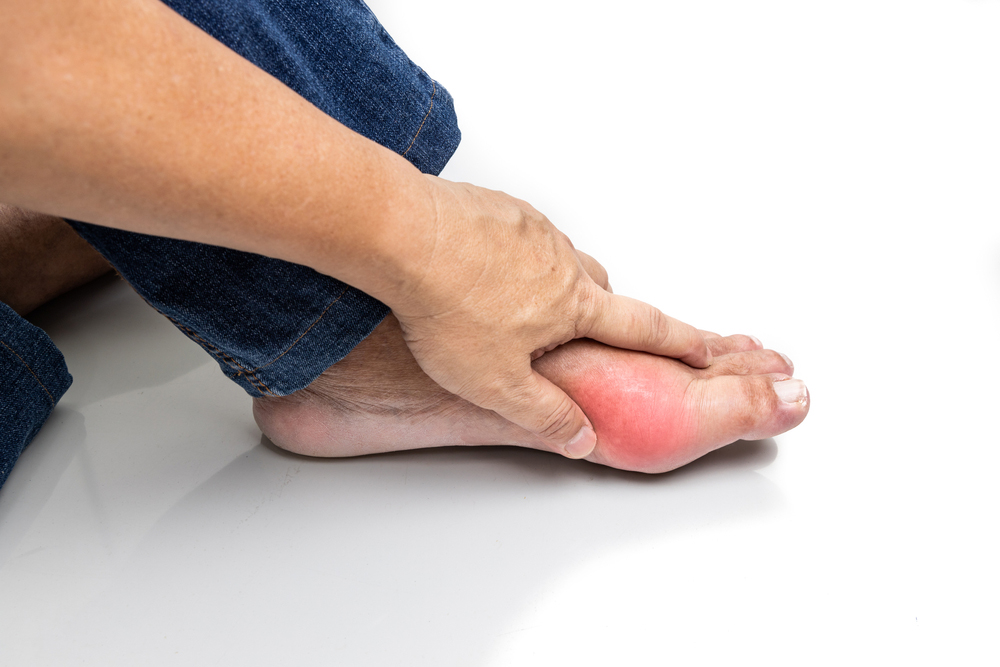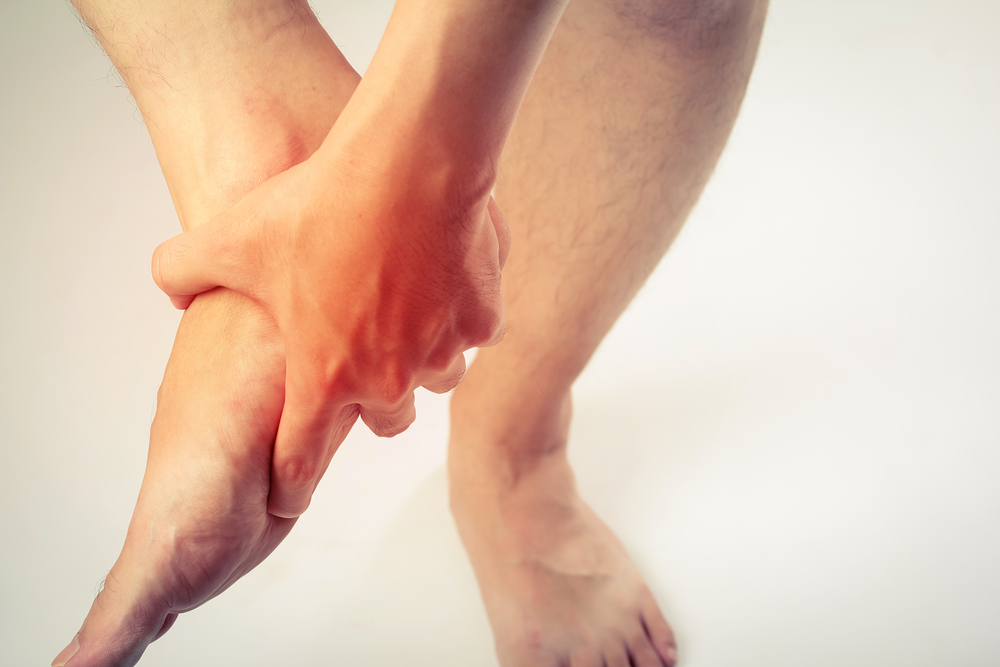
 Gout is a type of arthritis caused by a buildup of uric acid in the bloodstream. This acid can crystallize and become lodged in the joints of the feet, leading to sudden and intense pain, swelling, and inflammation. Gout typically flares up and then goes away, only to flare up again in the future. It can become a chronic condition if measures are not taken to prevent future flare ups. Chronic gout can cause large, visible bumps, called tophi, to form in bones, joints, or cartilage. Tophi are made of urate crystals and are usually not painful unless they become infected or press on a nerve. But although they’re not painful in and of themselves, tophi are problematic because they can damage joints, destroy cartilage, and eventually lead to bone erosion, deformity, and disability. For more information about gout, please consult with a podiatrist.
Gout is a type of arthritis caused by a buildup of uric acid in the bloodstream. This acid can crystallize and become lodged in the joints of the feet, leading to sudden and intense pain, swelling, and inflammation. Gout typically flares up and then goes away, only to flare up again in the future. It can become a chronic condition if measures are not taken to prevent future flare ups. Chronic gout can cause large, visible bumps, called tophi, to form in bones, joints, or cartilage. Tophi are made of urate crystals and are usually not painful unless they become infected or press on a nerve. But although they’re not painful in and of themselves, tophi are problematic because they can damage joints, destroy cartilage, and eventually lead to bone erosion, deformity, and disability. For more information about gout, please consult with a podiatrist.
Gout is a painful condition that can be treated. If you are seeking treatment, contact Dr. Robert Hope of Riverside Podiatry. Our doctor
will treat your foot care needs.
What Is Gout?
Gout is a form of arthritis that is characterized by sudden, severe attacks of pain, redness, and tenderness in the joints. The condition usually affects the joint at the base of the big toe. A gout attack can occur at any random time, such as the middle of the night while you are asleep.
Symptoms
Risk Factors
Prior to visiting your podiatrist to receive treatment for gout, there are a few things you should do beforehand. If you have gout you should write down your symptoms--including when they started and how often you experience them, important medical information you may have, and any questions you may have. Writing down these three things will help your podiatrist in assessing your specific situation so that he or she may provide the best route of treatment for you.
If you have any questions please feel free to contact our office located in Tuscaloosa, and Fayette, AL . We offer the newest diagnostic and treatment technologies for all your foot needs.
 The plantar fascia is a long, thick band of tissue that spans from the heel bone along the bottom of the foot to the toes. The plantar fascia supports the bottom of the feet and toes (as the heel rises) during walking, running, and jumping. The plantar fascia can become overly stressed or even tear or rupture from overuse or injury, causing pain and inflammation (plantar fasciitis). Being obese, standing/working on your feet for prolonged periods of time, having flat feet or high arches, and engaging in activities that involve dancing, marching or running can all contribute to, or worsen the symptoms of, plantar fasciitis. Wearing certain footwear can also put you at an increased risk of developing this condition such as high heels, flip flops, worn out shoes, or other types of footwear with inadequate support. A podiatrist will use a variety of treatment protocols to treat plantar fasciitis depending upon the severity of the condition and how long the patient has been suffering from it. A combination of rest, icing, stretching, taping, protective footwear, orthotics, and pain medication may be used to help heal the damage done to the plantar fascia and reduce pain and inflammation. A podiatrist may treat more severe or chronic plantar fasciitis (including cases that don’t respond to initial treatment) with steroid injections, laser therapy, or even surgery.
The plantar fascia is a long, thick band of tissue that spans from the heel bone along the bottom of the foot to the toes. The plantar fascia supports the bottom of the feet and toes (as the heel rises) during walking, running, and jumping. The plantar fascia can become overly stressed or even tear or rupture from overuse or injury, causing pain and inflammation (plantar fasciitis). Being obese, standing/working on your feet for prolonged periods of time, having flat feet or high arches, and engaging in activities that involve dancing, marching or running can all contribute to, or worsen the symptoms of, plantar fasciitis. Wearing certain footwear can also put you at an increased risk of developing this condition such as high heels, flip flops, worn out shoes, or other types of footwear with inadequate support. A podiatrist will use a variety of treatment protocols to treat plantar fasciitis depending upon the severity of the condition and how long the patient has been suffering from it. A combination of rest, icing, stretching, taping, protective footwear, orthotics, and pain medication may be used to help heal the damage done to the plantar fascia and reduce pain and inflammation. A podiatrist may treat more severe or chronic plantar fasciitis (including cases that don’t respond to initial treatment) with steroid injections, laser therapy, or even surgery.
Plantar fasciitis can be very painful and inconvenient. If you are experiencing heel pain or symptoms of plantar fasciitis, contact Dr. Robert Hope of Riverside Podiatry. Our doctor can provide the care you need to keep you pain-free and on your feet.
What Is Plantar Fasciitis?
Plantar fasciitis is the inflammation of the thick band of tissue that runs along the bottom of your foot, known as the plantar fascia, and causes mild to severe heel pain.
What Causes Plantar Fasciitis?
How Can It Be Treated?
While very treatable, plantar fasciitis is definitely not something that should be ignored. Especially in severe cases, speaking to your podiatrist right away is highly recommended to avoid complications and severe heel pain. Your podiatrist can work with you to provide the appropriate treatment options tailored to your condition.
If you have any questions please feel free to contact our office located in Tuscaloosa, and Fayette, AL . We offer the newest diagnostic and treatment technologies for all your foot needs.
On the inside of the ankle lies a narrow passageway created by soft tissue and bone, called the tarsal tunnel. Traveling through the tarsal tunnel are tendons, blood vessels, and nerves—including the tibial nerve. This nerve can become compressed within the narrow space of the tarsal tunnel by a variety of conditions that take up space within it. These conditions include lesions or masses, enlarged veins, benign bony growths, and tumors of nerve fibers or ganglion cells. Certain injuries or trauma, as well as having flat feet can contribute to the development of tarsal tunnel syndrome. Tarsal tunnel syndrome can cause pain, tingling, or burning anywhere on the tibial nerve, which runs from the ankle up through the back of the leg. If you believe you may have tarsal tunnel syndrome, schedule an appointment with a podiatrist who will examine you, and may also use nerve tests and imaging to help diagnose the issue. Treatment for tarsal tunnel syndrome may include icing, resting, anti-inflammatory medicines, custom orthotics, and physical therapy. More severe cases may require steroid injections or even surgery to increase space within the tunnel and reduce pressure on the nerve.
Tarsal tunnel syndrome can be very uncomfortable to live with. If you are experiencing tarsal tunnel syndrome, contact Dr. Robert Hope of Riverside Podiatry. Our doctor can provide the care you need to keep you pain-free and on your feet.
Tarsal Tunnel Syndrome
Tarsal tunnel syndrome, which can also be called tibial nerve dysfunction, is an uncommon condition of misfiring peripheral nerves in the foot. The tibial nerve is the peripheral nerve in the leg responsible for sensation and movement of the foot and calf muscles. In tarsal tunnel syndrome, the tibial nerve is damaged, causing problems with movement and feeling in the foot of the affected leg.
Common Cause of Tarsal Tunnel Syndrome
The Effects of Tarsal Tunnel Syndrome
A physical exam of the leg can help identify the presence of tarsal tunnel syndrome. Medical tests, such as a nerve biopsy, are also used to diagnose the condition. Patients may receive physical therapy and prescriptive medication. In extreme cases, some may require surgery.
If you have any questions please feel free to contact our office located in Tuscaloosa, and Fayette, AL . We offer the newest diagnostic and treatment technologies for all your foot needs.